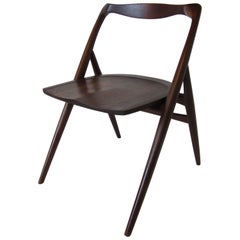George Suyeoka
Mid-20th Century American American Craftsman Chairs
Wood, Walnut
People Also Browsed
2010s American Modern Wall Lights and Sconces
Travertine, Marble, Brass, Bronze
21st Century and Contemporary Brazilian Modern Carts and Bar Carts
Steel
2010s American Modern Chandeliers and Pendants
Brass, Bronze, Enamel, Nickel
Mid-20th Century French Mid-Century Modern Cabinets
Aluminum
21st Century and Contemporary American Modern Daybeds
Fabric, Wood
Vintage 1960s Italian Mid-Century Modern Chandeliers and Pendants
Brass, Metal
Vintage 1940s Italian Neoclassical Revival Chandeliers and Pendants
Brass
2010s British Mid-Century Modern Wall Mirrors
Brass, Bronze
21st Century and Contemporary Swedish Scandinavian Modern Wall Lights an...
Brass
Antique 1890s Great Britain (UK) Arts and Crafts Fireplaces and Mantels
Copper, Enamel
Mid-20th Century American Mid-Century Modern Table Lamps
Metal
2010s American Organic Modern Coffee and Cocktail Tables
Hardwood, Walnut
2010s Italian Modern Chandeliers and Pendants
Brass
Vintage 1960s Danish Scandinavian Modern Armchairs
Leather, Oak
20th Century Italian Mid-Century Modern Chandeliers and Pendants
Crystal, Brass
20th Century American Mid-Century Modern Credenzas
Walnut
A Close Look at American-craftsman Furniture
Inspired by the Arts & Crafts style in England, which rebelled against the mechanization of the Industrial Revolution with a proud emphasis on handcrafted design, American Craftsman style similarly pushed against the lavishness of the Victorian era. Coined by Wisconsin-born Gustav Stickley, a furniture designer and publisher of The Craftsman magazine, American Craftsman furniture would influence homegrown styles that followed, such as Mission and the Prairie School.
Like the popular early 20th-century Craftsman houses — which feature meticulous woodwork on everything from built-in bookcases in the living room and cabinetry in the kitchen to earth-toned exteriors with exposed rafters — American Craftsman furniture was all about handmade storage cabinets, bedroom furniture, chairs and other pieces built with organic materials. “Simplicity and straightforwardness of construction has always been the leading characteristic of Craftsman furniture,” Stickley stated. And while he is often credited with most of the designs at the Craftsman Workshops in Eastwood, New York, others such as Harvey Ellis were influential in shaping the straight-backed chairs, beds with vertical slats and tables with exposed joinery that came to define the style.
Highly utilitarian with no unnecessary flair, American Craftsman furniture was designed to emphasize the essence of its modest construction and promote the natural beauty of the wood. Solid oak, cherry, walnut and mahogany were all favored by the movement’s principal figures. Another attribute commonly associated with the style is the integration of subtle details like tooled leather, inlaid metal and hammered iron handles.
Owing to the outbreak of World War I, the popularity of American Craftsman style waned as consumer spending dropped and furniture companies shifted to the production of wartime materials and goods specified in government contracts. Yet, by the 1960s, there was a renewed appreciation for this foundational modern American style, with Stickley and his contemporaries in demand for the clean, simple lines and sturdy construction of American Craftsman furniture.
Find a collection of antique American Craftsman chests, nightstands, seating, decorative objects and more furniture on 1stDibs.
Finding the Right Chairs for You
Chairs are an indispensable component of your home and office. Can you imagine your life without the vintage, new or antique chairs you love?
With the exception of rocking chairs, the majority of the seating in our homes today — Windsor chairs, chaise longues, wingback chairs — originated in either England or France. Art Nouveau chairs, the style of which also originated in those regions, embraced the inherent magnificence of the natural world with decorative flourishes and refined designs that blended both curved and geometric contour lines. While craftsmanship and styles have evolved in the past century, chairs have had a singular significance in our lives, no matter what your favorite chair looks like.
“The chair is the piece of furniture that is closest to human beings,” said Hans Wegner. The revered Danish cabinetmaker and furniture designer was prolific, having designed nearly 500 chairs over the course of his lifetime. His beloved designs include the Wishbone chair, the wingback Papa Bear chair and many more.
Other designers of Scandinavian modernist chairs introduced new dynamics to this staple with sculptural flowing lines, curvaceous shapes and efficient functionality. The Paimio armchair, Swan chair and Panton chair are vintage works of Finnish and Danish seating that left an indelible mark on the history of good furniture design.
“What works good is better than what looks good, because what works good lasts,” said Ray Eames.
Visionary polymaths Ray and Charles Eames experimented with bent plywood and fiberglass with the goal of producing affordable furniture for a mass market. Like other celebrated mid-century modern furniture designers of elegant low-profile furnishings — among them Ludwig Mies van der Rohe and Finn Juhl — the Eameses considered ergonomic support, durability and cost, all of which should be top of mind when shopping for the perfect chair. The mid-century years yielded many popular chairs.
The Eameses introduced numerous icons for manufacturer Herman Miller, such as the Eames lounge chair and ottoman, molded plywood dining chairs the DCM and DCW (which can be artfully mismatched around your dining table) and a wealth of other treasured pieces for the home and office.
A good chair anchors us to a place and can become an object of timeless appeal. Take a seat and browse the rich variety of vintage, new and antique chairs on 1stDibs today.
